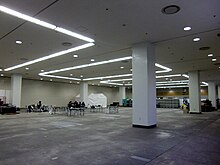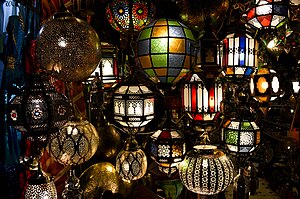
Stage lighting is the craft of lighting as it applies to the production of theater, dance, opera, and other performance arts. Several different types of stage lighting instruments are used in this discipline. In addition to basic lighting, modern stage lighting can also include special effects, such as lasers and fog machines. People who work on stage lighting are commonly referred to as lighting technicians or lighting designers.
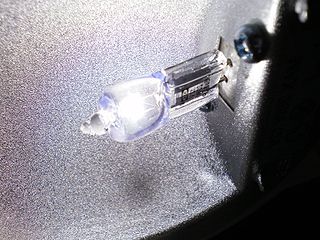
A halogen lamp is an incandescent lamp consisting of a tungsten filament sealed in a compact transparent envelope that is filled with a mixture of an inert gas and a small amount of a halogen, such as iodine or bromine. The combination of the halogen gas and the tungsten filament produces a halogen-cycle chemical reaction, which redeposits evaporated tungsten on the filament, increasing its life and maintaining the clarity of the envelope. This allows the filament to operate at a higher temperature than a standard incandescent lamp of similar power and operating life; this also produces light with higher luminous efficacy and color temperature. The small size of halogen lamps permits their use in compact optical systems for projectors and illumination. The small glass envelope may be enclosed in a much larger outer glass bulb, which has a lower temperature, protects the inner bulb from contamination, and makes the bulb mechanically more similar to a conventional lamp.

Lighting or illumination is the deliberate use of light to achieve practical or aesthetic effects. Lighting includes the use of both artificial light sources like lamps and light fixtures, as well as natural illumination by capturing daylight. Daylighting is sometimes used as the main source of light during daytime in buildings. This can save energy in place of using artificial lighting, which represents a major component of energy consumption in buildings. Proper lighting can enhance task performance, improve the appearance of an area, or have positive psychological effects on occupants.
An antifuse is an electrical device that performs the opposite function to a fuse. Whereas a fuse starts with a low resistance and is designed to permanently break or open an electrically conductive path, an antifuse starts with a high resistance--an open circuit--and programming it converts it into a permanent electrically conductive path. This technology has many applications. Antifuses are best known for their use in mini-light style low-voltage Christmas tree lights.

A compact fluorescent lamp (CFL), also called compact fluorescent light, energy-saving light and compact fluorescent tube, is a fluorescent lamp designed to replace an incandescent light bulb; some types fit into light fixtures designed for incandescent bulbs. The lamps use a tube that is curved or folded to fit into the space of an incandescent bulb, and a compact electronic ballast in the base of the lamp.

An emergency light is a battery-backed lighting device that switches on automatically when a building experiences a power outage.
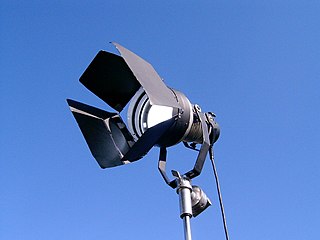
Hydrargyrum medium-arc iodide (HMI) is the trademark name of Osram's brand of metal-halide gas discharge medium arc-length lamp, made specifically for film and entertainment applications. Hydrargyrum comes from the Greek name for the element mercury.
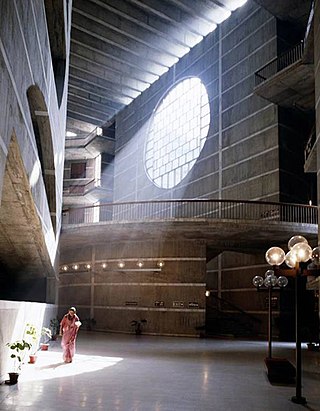
Architectural lighting design is a field of work or study that is concerned with the design of lighting systems within the built environment, both interior and exterior. It can include manipulation and design of both daylight and electric light or both, to serve human needs.

The sulfur lamp is a highly efficient full-spectrum electrodeless lighting system whose light is generated by sulfur plasma that has been excited by microwave radiation. They are a particular type of plasma lamp, and one of the most modern. The technology was developed in the early 1990s, but, although it appeared initially to be very promising, sulfur lighting was a commercial failure by the late 1990s. Since 2005, lamps are again being manufactured for commercial use.

A dropped ceiling is a secondary ceiling, hung below the main (structural) ceiling. It may also be referred to as a drop ceiling, T-bar ceiling, false ceiling, suspended ceiling, grid ceiling, drop in ceiling, drop out ceiling, or ceiling tiles and is a staple of modern construction and architecture in both residential and commercial applications.

A light fixture, light fitting, lamp, or luminaire is an electrical device containing an electrical component called a lamp that provides illumination. All light fixtures have a fixture body and one or more lamps. The lamps may be in sockets for easy replacement—or, in the case of some LED fixtures, hard-wired in place.

Cove lighting is a form of indirect lighting built into ledges, recesses, or valances in a ceiling or high on the walls of a room. It directs light up towards the ceiling and down adjacent walls. It may be used as primary lighting, or for aesthetic accent, especially to highlight decorative ceilings. Cove lighting is valued because it hides the fixtures, and because it provides a very even light.

A bayonet mount or bayonet connector is a fastening mechanism consisting of a cylindrical male side with one or more radial pins, and a female receptor with matching L-shaped slot(s) and with spring(s) to keep the two parts locked together. The slots are shaped like a capital letter L with serif ; the pin slides into the vertical arm of the L, rotates across the horizontal arm, then is pushed slightly upwards into the short vertical "serif" by the spring; the connector is no longer free to rotate unless pushed down against the spring until the pin is out of the "serif".

A multifaceted reflector light bulb is a reflector housing format for halogen as well as some LED and fluorescent lamps. MR lamps were originally designed for use in slide projectors, but see use in residential lighting and retail lighting as well. They are suited to applications that require directional lighting such as track lighting, recessed ceiling lights, desk lamps, pendant fixtures, landscape lighting, retail display lighting, and bicycle headlights. MR lamps are designated by symbols such as MR16 where the diameter is represented by numerals indicating units of eighths of an inch. Common sizes for general lighting are MR16 and MR11, with MR20 and MR8 used in specialty applications. Many run on low voltage rather than mains voltage alternating current so require a power supply.

Track lighting is a method of lighting where light fixtures are attached anywhere on a continuous track device which contains electrical conductors. This is in contrast to directly routing electrical wiring to individual light positions. Tracks can either be mounted to ceilings or walls, lengthwise down beams, or crosswise across rafters or joists. They can also be hung with rods from especially high places like vaulted ceilings.

A bipin or bi-pin is a type of lamp fitting. They are included in the IEC standard "IEC 60061 Lamp caps and holders together with gauges for the control of interchangeability and safety". They are used on many small incandescent light bulbs, and for starters on some types of fluorescent lights.

An LED lamp or LED light is an electric light that produces light using light-emitting diodes (LEDs). LED lamps are significantly more energy-efficient than equivalent incandescent lamps and fluorescent lamps. The most efficient commercially available LED lamps have efficiencies exceeding 200 lumens per watt (lm/W) and convert more than half the input power into light. Commercial LED lamps have a lifespan several times longer than both incandescent and fluorescent lamps.
Often task lighting refers to increasing illuminance to better accomplish a specific activity. However, the illuminance level is not the only factor governing visibility. Contrast is also important, and a poorly positioned light source may cause contrast reduction, resulting in loss of visibility. The most important purpose of task lighting in the office is not increasing illuminance, but improving contrast. General lighting can be reduced because task lighting provides focused light where needed.

Vari-Lite is a brand of automated, variable-colour stage lighting systems. Their intelligent lighting fixtures are commonly used in theatre, concerts, television, film and corporate events.

Hybrid solar lighting (HSL) or hybrid lighting systems combine the use of solar with artificial light for interior illumination by channelling sunlight through fiber optic cable bundles to provide solar light into rooms without windows or skylights, and by supplementing this natural light with artificial light—typically LED—as required.

